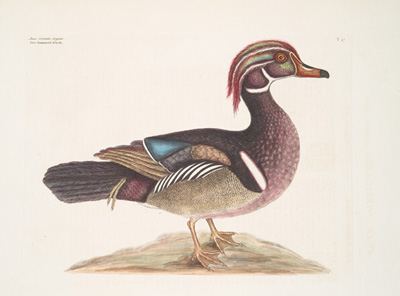

• Intro / Home
• Historical Neighbors
• Street and Backyard
Neighbors
• Park and Green Places
Neighbors
• Shore and Wetlands
Neighbors
• Salt and Freshwater
Neighbors
• Tiny Neighbors
• Unwelcome Neighbors
• Occasional and
Unexpected Neighbors
•
Wildlife Sighting Log
• Resources
• Hours and Tours
• Press Release
• NYPL HOME
| Shore and Wetlands Neighbors | |
 |
||
|
|
Mark Catesby’s (1683–1749) great achievement in creating the first extensive study of American ornithology is the more remarkable in that he not only collected and preserved bird and botanical specimens, made the drawings, and wrote the text, but also etched all the plates and hand-colored many of them himself. While the bird portraits are not always accurate, all are recognizable. His portrait of a male Wood Duck, surely the most colorful and arguably the most beautiful of native waterfowl, has fanciful head plumage, but the essential characteristics of the bird are indisputably recorded. Depending on who the artisans were, copies of this posthumously published 2nd edition vary in the accuracy of the coloration. Thus, The New York Public Library copy not only shows the duck’s belly as dark rather than the correct light hue, but includes bizarre purple and pink plumage. Check out the sighting log to record your interaction with some of the native New York City wildlife, such as the Wood Duck, featured in Urban Neighbors. You may also browse the sighting log by animal, borough, park or natural area, and/or habitat to view a sighting you have submitted or to read others’ observations. |